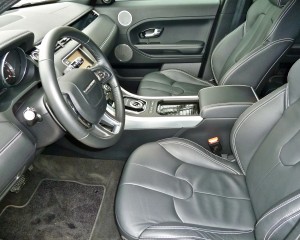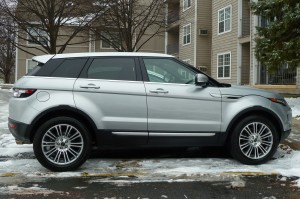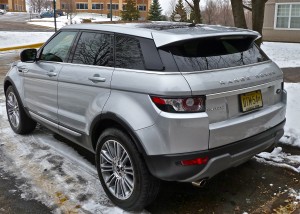Evoque drives Range Rover into future
By John Gilbert
What’s a sleek shape like you, doing with a name like Range Rover? That’s a fair question to ask of the 2012 Evoque, a departure that may prove the direction of Range Rover SUVs from now on.
Since 1948, Range Rover has solidly over-engineered SUVs before the nickname was invented, and all of them could conquer the most rugged off-road challenges. As years passed, they refined the Range Rover and Land Rover vehicles until they became the prestige cars of choice for customers who could afford to display their taste for unexcelled quality and versatility. Refinement never threatened Range Rover’s distinctive square shape at all four corners, however. Until now, that is.
A couple of years ago, the LRX, a Range Rover concept vehicle, Â hit auto shows with a startling new shape. Its chances to advance beyond concept stage seemed remote, but last year, the production Evoque became the newest auto show specimen, but it still seemed mostly fantasy. Suddenly, for 2012, the Range Rover Evoque has come to life and is on the road.
From the front, it bears a streamlined resemblance to the recognizable boxes of Range Rovers past. The rest of the body, however, leaves behind the boxy silhouette for a much sportier, sloped-back look. Its light and lean looks make sense, because it is the smallest and lightest Range Rover, with unique styling that stands out from all its siblings, and all other SUVs as well.
It performs as impressively as it looks, taking off with surprising swiftness. You can upshift through six gears by using steering wheel paddles, if you choose to manually override the 6-speed automatic transmission’s capabilities. It also cruises effortlessly at freeway speeds.
My test-drive Evoque was a 4-door in Indus Silver, wearing Prestige trim. The Evoque comes in an extra-sleek 2-door “coupe†design as well, which has an even sportier appearance, although the tapered roof of the test Evoque pretty effectively hides the fact it has four doors. Evoques come in Pure, Prestige, and Dynamic trim, with Pure being basic — but pretty fully loaded, while Prestige adds special 19-inch or available 20-inch wheels and tires and is filled with opulent creature comforts, and Dynamic is dressed for sporty use, with bolder interior schemes.
When I first climbed behind the wheel, I was impressed by the familiar luxury and support of the Evoque interior, and with new and contemporary cockpit instruments. I was even more impressed when I stepped on the gas and launched the beast — swiftly.
Range Rover has remained distinctly British, and has used a variety of engines through the years, from Buick to Jaguar. For a time, both Range Rover and Jaguar were owned by Ford, which later sold both to Tata Motors of India. The larger Range Rovers use Jaguar’s impressive and high-powered 5.0-liter V8, some of them supercharged, with more power than anyone could need.
With the Evoque, the link with Ford still pays dividends, because Range Rover contracted to obtain Ford’s newest 2.0-liter EcoBoost 4-cylinder engine. This is the high-powered turbocharged engine Ford is putting in its new Escape, and makes available in the Explorer as well, with the power of a V6 or V8, but the fuel economy promised by a 4-cylinder.
If it seems odd to have only four cylinders in a Range Rover, consider that with direct injection, turbocharging, and twin variable valve-timing, the 2.0 puts 240 horsepower and 250 foot-pounds of torque through a 6-speed transmission, and 0-60 times have been clocked at 7.1 seconds.
The Evoque meets all the standards of over-engineered Range Rovers. Advanced high-strength steel is used in the monococque unitized capsule, which is then placed on front and rear subframes. Body panels are zinc-coated steel, with aluminum roof panels and hood, and magnesium cross beams.
As impressive as the spirited performance is the fuel economy. As we come to grips with more economy and ecology based driving, when I filled up with regular gas and combined driving around Minneapolis and on a 165-mile trip north to Duluth, where an early snowfall did nothing to threaten the all-wheel-drive Evoque, I calculated 27.1 miles per gallon.
Through the years, Range Rover vehicles always have had lengthy suspension travel to enhance their ability to astound drivers with how steeply they can ascend, descend, or crawl over walls or rocky obstacles, while remaining flat in attitude. They also have been famous for ultra-civilized road-handling demeanor, which made them perfect for coming out of the California mountains in time to take the family shopping in Beverly Hills or Monterey. The Evoque loses none of that pizzaz or panache, although it rides with much less roll and more stability. It has Magne-Ride suspension control, and console adjustment settings for whatever type of encounter is at hand.
The Evoque is the latest example of how well Range Rover engineers are able to take so much technical expertise and combine it with rock-solid stability, yet give their vehicles a velvet-smooth ability to be the best at either extreme of capability. To make sure it could do the job off-road, the engineers took the EcoBoost 2.0 and altered its oil system to be able to handle 45 degrees of side-hill operation, refining smoothness with twin balance shafts, making sure it could be fitted so the Evoque could slosh through water as deep as 500 mm., and assuring it had the power to pull trailers.
The permanent “intelligent†Haldex all-wheel drive with traction control is tuned to specific Land Rover specifications. The terrain response system can be clicked into general, snow, mud or sand for specific operation, and the 6-speed automatic can be set for normal, sport, or manual shift modes, for complete control of any terrain and any driving demand or driver mood.
The dynamic stability control is reinforced with roll stability control, electronic brake-force distribution, cornering brake control — which actually helps keep your attempted turn in a manageable trajectory — hill-descent control — which relieves the brakes of sole responsibility for harnessing downhill speed — emergency brake assist, trailer stability assist, and hill start assist — which prevents the tendency to roll backwards on startup.
All of that high-tech stuff is standard, and while they may sound as though Big Brother is trying to take over operation, in reality, all those features only enhance the driver’s ability to make the Evoque perform seemingly impossible tasks as if instinctively.
Reality, of course, is that about 95 percent of SUV buyers never venture off the road, and may consider off-roading a drive down a gravel trail to a cabin on a Northland lake. Range Rover owners have a higher incidence of off-roading than most, and if not as high as Jeep Wrangler buyers, the very capability of being able to over-achieve in canyon rock-crawling is part of the allure of any Range Rover or Land Rover. While on the road, the Evoque stays firmly planted for fully controlled driving through tight curves on roads of any quality.
All Range Rover/Land Rover vehicles have that capability, but the difference is, other siblings surprise you with their stability; the Evoque, with its lower roofline and more aggressive stance, not only looks like it should handle the best, it does. As the smallest and lightest of all Range Rovers, it doesn’t lean or show any other foul manners in twisty curves.
Along with all the driving devices that are standard on every Evoque, everything from rain-sensing wipers, keyless entry, front and rear parking distance alerts, rear camera, power tailgate, side impact door beams front and rear, and a cocoon of seven airbags, a 380-watt, 11-speaker Meridian audio system with AM, FM, CD, MP3, Bluetooth phone connectivity, with streaming audio plus USB and iPod hookups — come standard on the base Evoque, which is listed at $41,145.
If scanning those features leaves you breathlessly assuming you couldn’t possibly think of anything more to add, check out the Prestige Premium package, which includes special design of the 19-inch wheels, real wood finishes, storage racks for the load space, 8-way driver and 6-way passenger seats of premium leather, with Oxford leather dashboard panel, surround camera system, navigation with voice control, and increasing the Meridian audio to 825-watt surround, with 17 speakers, plus Xenon headlights. That package, on the test vehicle, tallies at $10,400.
In addition, cold-weather buyers can add the climate control pack with its heated front seats and windshield, steering wheel and washer jets for another $1,000. Sirius satellite radio and HD radio, plus a rear seat entertainment set with dual 8-inch screens, and a DVD player with wireless headphones and remote control, load up the $41,145 sticker to a whopping $56,920. That’s a lot, but it also helps underline the bargain nature of the $41,145 pre-option price.
There aren’t many SUVs at any price that accelerate and handle as well as the Evoque, fewer that can rival its almost-futuristic looks, and fewer still that can actually attain 27 real-world miles per gallon.
Comments
Tell me what you're thinking...
and oh, if you want a pic to show with your comment, go get a gravatar!







 John Gilbert is a lifetime Minnesotan and career journalist, specializing in cars and sports during and since spending 30 years at the Minneapolis Tribune, now the Star Tribune. More recently, he has continued translating the high-tech world of autos and sharing his passionate insights as a freelance writer/photographer/broadcaster. A member of the prestigious North American Car and Truck of the Year jury since 1993. John can be heard Monday-Friday from 9-11am on 610 KDAL(www.kdal610.com) on the "John Gilbert Show," and writes a column in the Duluth Reader.
John Gilbert is a lifetime Minnesotan and career journalist, specializing in cars and sports during and since spending 30 years at the Minneapolis Tribune, now the Star Tribune. More recently, he has continued translating the high-tech world of autos and sharing his passionate insights as a freelance writer/photographer/broadcaster. A member of the prestigious North American Car and Truck of the Year jury since 1993. John can be heard Monday-Friday from 9-11am on 610 KDAL(www.kdal610.com) on the "John Gilbert Show," and writes a column in the Duluth Reader.